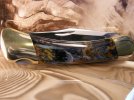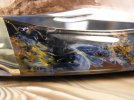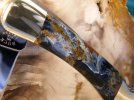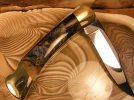- Joined
- May 21, 2007
- Messages
- 1,432
Here are a few pictures of a Buck 110 done with a very rare stone - Pietersite.
Pietersite will always have brecciated, fibrous bands of blue, gold and/or red tiger eye type fibers in quartz. The fibrous structure in pietersite has been folded, stressed, even fractured and/or broken apart via the earth's geologic processes. The fibrous materials have then been reformed and naturally recemented together by quartz. Stones and crystals that go through this process are referred to as brecciated, creating a finished product with multiple colors, hues and superb chatoyancy.
While pietersite has the lovely chatoyancy of tiger eye, it is not found in continuously structured bands or fibers, more in swirls, swathes and fibrous (sometimes linear) segments. Thus the structure of the fibrous streaks in pietersite may appear rather chaotic, and can flow or exist in many directions side-by-side like bold paint strokes.
Colors include various blues, golds and reds, that may appear together or alone. Blue is the rarest color, followed by red. The blues range from a baby blue to dark midnight hue. All fibrous color variations will have a superb and striking chatoyancy, the bright and subtly changing shimmer of color that moves along the surface of a gemstone as it is viewed from varying angles.




Pietersite will always have brecciated, fibrous bands of blue, gold and/or red tiger eye type fibers in quartz. The fibrous structure in pietersite has been folded, stressed, even fractured and/or broken apart via the earth's geologic processes. The fibrous materials have then been reformed and naturally recemented together by quartz. Stones and crystals that go through this process are referred to as brecciated, creating a finished product with multiple colors, hues and superb chatoyancy.
While pietersite has the lovely chatoyancy of tiger eye, it is not found in continuously structured bands or fibers, more in swirls, swathes and fibrous (sometimes linear) segments. Thus the structure of the fibrous streaks in pietersite may appear rather chaotic, and can flow or exist in many directions side-by-side like bold paint strokes.
Colors include various blues, golds and reds, that may appear together or alone. Blue is the rarest color, followed by red. The blues range from a baby blue to dark midnight hue. All fibrous color variations will have a superb and striking chatoyancy, the bright and subtly changing shimmer of color that moves along the surface of a gemstone as it is viewed from varying angles.




